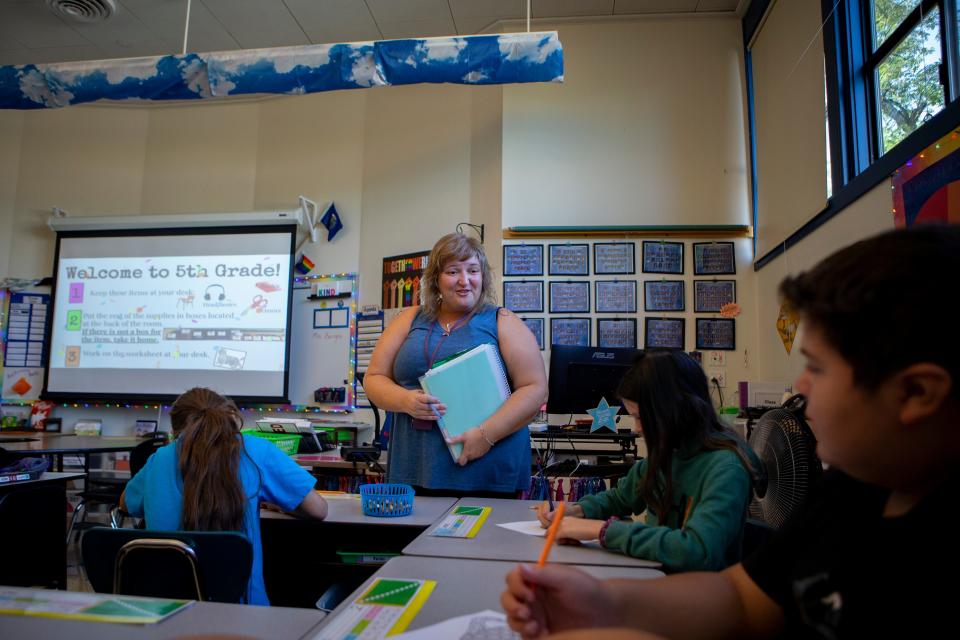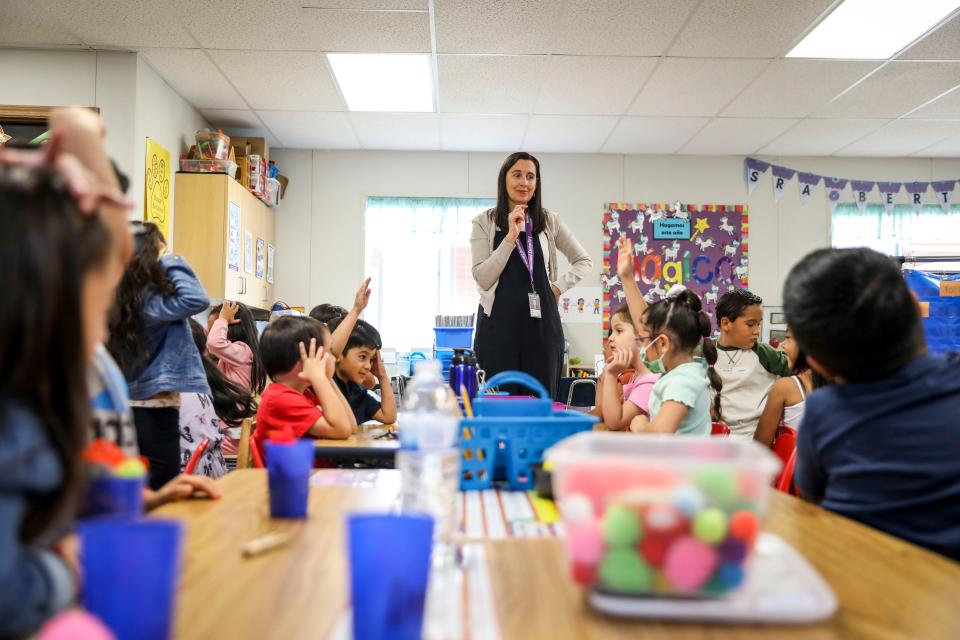2023 teacher shortages: What to know about vacancies on the West Coast
As the 2023-2024 school year ramps up, schools districts across the country are confronted with yet another year of staff shortages. From four-day school weeks and expanded teacher certificate programs to recruiting custodians and lunchroom workers, schools are finding creative short-term solutions to address the ongoing crisis.
Last year, the National Center for Education Statistics' (NCES) School Pulse Panel reported 42% of all principals said teachers and staff leaving the profession became a "more pressing concern" during the last school year.
Trends in staff shortages are even worse for schools with large numbers of minority students. About 4 in 10 schools with more than 75% minority populations have multiple teaching vacancies, according to NCES.
How do teacher shortage trends vary by region and what subject areas are the most strained?
Teacher shortages in western states
Although some Oregon districts started classes last week and others are set to begin this week, some schools are still lacking enough classroom teachers. There is also a particular need in many districts for additional bus drivers.
In Salem-Keizer Public Schools as of Friday, there were 37 unfilled classroom positions and 18 open bus driver positions.
In the Eugene/Springfield metro area, teacher shortages were less prevalent. According to Eugene Education Association President Sabrina Gordon, Eugene School District 4J hired around 130 licensed teachers for the 2023-24 school year, and Bethel School District hired about 30.
As of Thursday, among the three metro districts, there were seven distinct, non-temporary, full-time teaching positions posted. For all three districts, several postings were listed as "multiple vacancies."
Eugene School District 4J had a total of 44 job openings posted including:
Nine temporary positions.
Five substitute positions.
11 educational assistant positions.
Seven coaching positions.
Six custodial or nutritional services positions.
Three mental health or counseling services positions.
Two bus drivers.
Springfield Public Schools had a total of 42 job openings posted, 26 of which were classified, including:
Five teaching positions (two of which were temporary).
Five substitute positions.
15 educational assistant positions.
Six coaching positions
Five custodial or nutritional services positions
One mental health position
Three bus drivers or transportation positions
Springfield's teaching positions include a P.E. teacher at Gateways High, an elementary special education teacher and a secondary-level special education teacher.
Bethel School District had 49 job openings posted, 37 of which were classified, including:
Four teaching positions.
Six temporary positions.
Five substitute positions.
19 educational assistant positions.
Three coaching positions.
Three custodial positions.
Two bus drivers or transportation positions.
Bethel's open teaching positions include instructional coaches, an elementary special education teacher, a speech language pathologist and a construction career technical education teacher.
Although the job postings reflect there is sufficient teachers, Gordon said that can change quickly throughout the year.
"It is an issue that we need to remain very aware of all the time," Gordon said. "Even if, at the moment, we're not feeling an acute teacher shortage in Eugene/Springfield, we can't just like sit back and relax and think that it's not coming because it will. It has and it will be back."
Gordon added a deficit of classified support staff can bring added stress on teachers. Gordon said the "whole team" of licensed and classified staff are needed in schools every day to support students.
Educational assistants had the highest number of job postings at each district. She said without that in-classroom support, teachers can become overwhelmed. Educational assistants not only can help in-classroom with individual instruction time, but they also offer teachers help with in-person planning.
"When we have large class sizes, which in Oregon, we do, in order to be able to meet the individual needs of every student, it takes more than one adult in a classroom," Gordon said. "Without the supports that kids need, the job isn't sustainable. And so again, we run the risk of losing great teachers if we don't have all the supports."
Gordon said it needs to be an ongoing effort to attract and retain teachers by providing supports, offering competitive wages, having good insurance options, and also creating a school district where teachers and staff feel valued and acknowledged.

Larry Delaney is a high school math teacher in Washington state and the president of the Washington Education Association. He said even when Washington state has the money to pay larger salaries and hire more educators, the supply of educators in high-need subject areas is not available.
“Let’s say the Legislature wants to fund one mental and behavioral health counselor per building in Washington. We have 4,000 school buildings in Washington state. But we don’t have 4,000 mental and behavioral health professionals looking for jobs,” Delaney said.
School districts are looking at short-term fixes to staff shortages, such as granting emergency teaching certificates to people who have not completed the preparation program. Although the shortage is addressed, Delaney said, it’s not best practice.
How do regional teacher shortages compare to the nation?
Washington, Oregon, California, Alaska and Nevada had some of the lowest teacher-to-student ratios across the nation, according to Scholaroo, an education research firm. According to its 2023 report, these western states fall in the bottom 25% of teacher shortages.
Scholaroo collected data on the number of teachers and students enrolled in public schools in each state to identify potential shortages.
Nevada has approximately 44 teachers available per 1,000 students enrolled in the state, or one teacher for every 23 students. Oregon's ratio was 57 teachers per 1,000 students, or one teacher for every 17.5 students.
While types of educator shortages range depending on the school district and state, Washington state suffers a shortage in early childhood educators along with special education professionals, according to the state’s Professional Educators Standards Board.
California is looking to hire more educators in special education, science, math, career technical subjects and bilingual educators, according to the California Department of Education.
Here's how national teacher shortages compare by subject area:
How are western states addressing teacher shortages?
Oregon and California allow educators with out-of-state licenses to apply for teaching positions in-state.
California invested money into California Student Aid Commission's Golden State Teacher Grant program as a way to attract new teachers, counselors, social workers and psychologists. The state also invested $1.5 billion toward the Educator Effectiveness Block Grant as a way to help teachers earn certain credentials or certifications in high-demand subjects.

The Washington Education Association is working with three school districts to recruit and train special education providers. The pilot program allows the WEA to provide special education certificates, becoming the first teachers union in the U.S. to do so, according to Delaney.
Four-day school weeks are another solution introduced to some local school districts. Currently, more than 1,600 schools across 24 states have implemented the shortened school week, according to the Oregon State University Four-Day School Week Policy Team.
Why is there a teacher shortage?
In some states, the increased cost of living outpaces the rate of teacher pay.
The combination of rising costs of college and stagnant teacher salaries has made it difficult for aspiring teachers to pursue this career. Federal data shows enrollment for traditional teacher preparation programs dropped by nearly a third between 2010 and 2018.
It’s not just unreasonable costs of living and low salaries that are discouraging teachers from continuing: Since the beginning of the pandemic, there has been a downward trend of teachers agreeing the “stress and disappointments” of their job are worth it.
According to annual educator surveys from the RAND Corporation, only half of all teachers agreed with this notion, compared to three-fourths of teachers who just a few years ago said the stress of teaching was worth it.
That’s nearly as problematic as not having enough teachers:
“Low morale matters in and of itself, whether or not teachers quit,” Heather Schwartz told USA TODAY.
Schwartz is RAND’s director of the Pre-K to 12 educational systems program and a senior policy researcher. Almost half of the teachers who voluntarily stopped teaching ahead of retirement in 2020 did so because of pandemic-related stress, RAND’s data suggests.
Where is teacher shortage data missing?
There isn’t reliable national data for tracking teacher vacancies. And some states fail to track whether educators are qualified to teach the classes they’re teaching, according to the National Council on Teacher Quality.
After evaluating states for their data collection practices, researchers at the council found that only 16 states published teacher demand data. While some states partially publish data on teacher demand, such as vacancy data, researchers are left with a patchwork of data sources, making it difficult to fully understand the national landscape of teacher shortages.
Dive deeper: Here's what the data says about teacher shortages
This article originally appeared on USA TODAY: Oregon, Washington and California face regional teacher shortages

